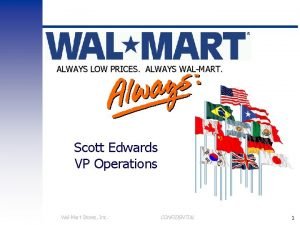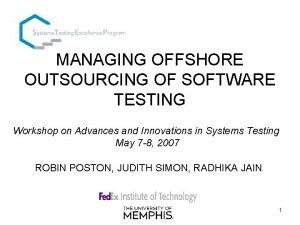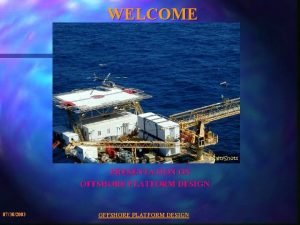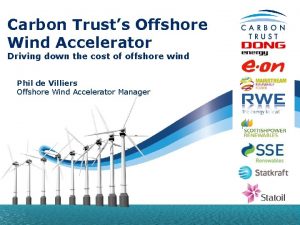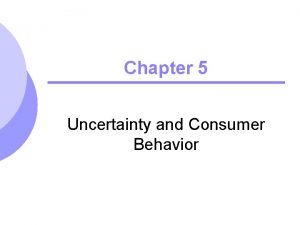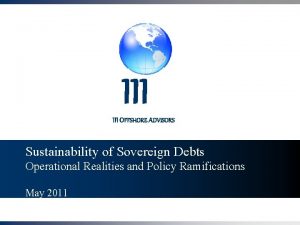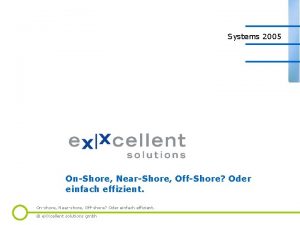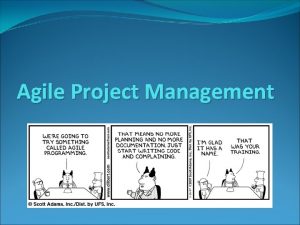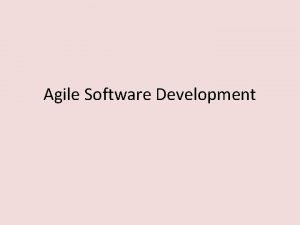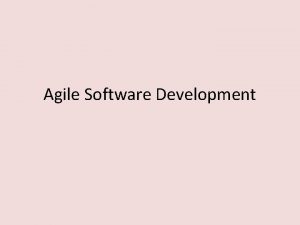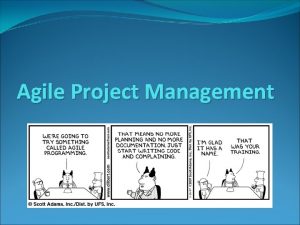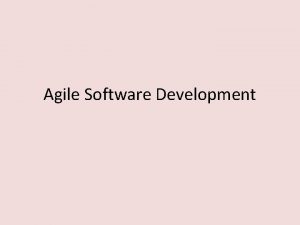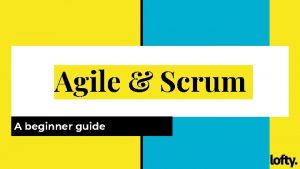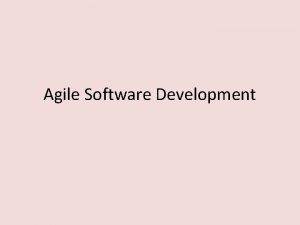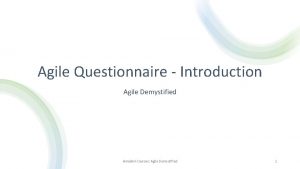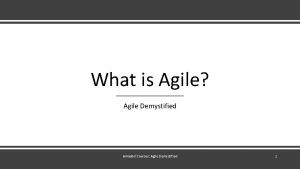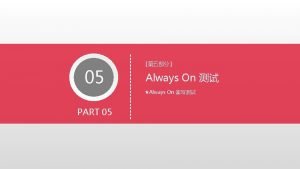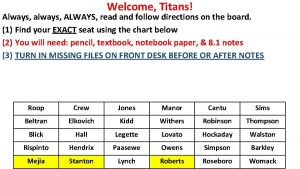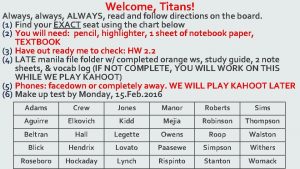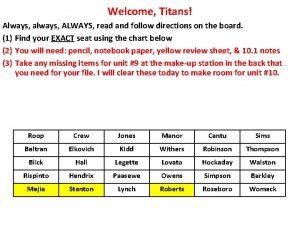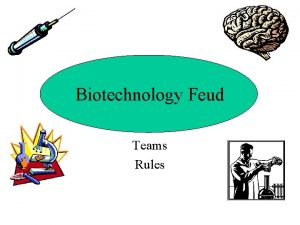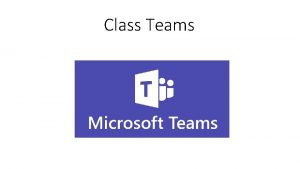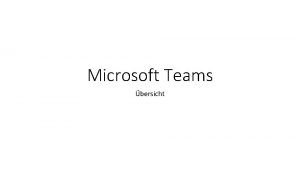OFFSHORE AGILE TEAMS ANDRE WILKERSON COLLOCATED IS ALWAYS


























- Slides: 26

OFFSHORE AGILE TEAMS ANDRE WILKERSON

COLLOCATED IS ALWAYS PREFERRED “The early agile literature was adamant about two things: 1)stick with small teams. 2)put everyone in one room. However, in the years since the Agile Manifesto, the increasing popularity of agile and the dramatic improvements it brings has pushed it onto larger and larger projects. ”

COLLOCATED IS ALWAYS PREFERRED “Additionally, having an entire team--especially on a large project--in one room, or even one building is a luxury no longer enjoyed by many projects. With multi-team projects being the reality, you need to know how to scale and how to work with agile distributed teams”. – Mike Cohn

4 AREAS OF INFLUENCE • Common Language • Culture • Communication • Common Vision (INCEPTION FRAMEWORK)

COMMON LANGUAGE : TAKE TIME TO LEARN THE AGILE UMBRELLA.

COMMON LANGUAGE • Framework VS Methodology. • Agile-Scrum : Practices and methodologies that can be supported by the Scrum framework. • Do your homework! Scrum, Crystal and lean are legitimate; Kanbazi listed on the previous slide seems to be the invention of Mohammas Sami in a group with 12 followers on Linked. In.

COMMON LANGUAGE : TAKE TIME TO LEARN THE AGILE UMBRELLA.

CULTURE : EMBRACE IT! • Quien aquí habla Español • Estudié español durante 3 semestres entonces yo practicaba cada oportunidad. Me encanta el idioma. • ¿Lo dije bien?

CULTURE • Mexico teammates would teach me on Spanish word every day. • Mexico teammates would all submit themes for Sprint names in both English and Spanish an explain the meanings to each other. (e. g. a feast for U. I’s) • Always…Always ask about the various Holidays ! ! !

CULTURE Holidays http: //www. officeholidays. com In India only the secular Holidays of Republic Day, Independence Day and Mahatma Gandhi’s Birthday are observed Nationally. (India) Major movie releases can be observed in grandiose fashion (Milking)

CULTURE http: //www. officeholidays. com/

CULTURE • In India the opening of a Major film can be an ostentatious event with fans mobbing theater and pouring milk on the cardboard cut outs of the actors for luck. • A lot of music found on soundtracks of modern Indian films mirror the production of American Pop. • There is a deeper understanding of the song writer, producer, performer and soundtrack details than the average American(*)

COMMUNICATION • Make all communication visible to the team using, “What's App” “Slack” Yammer • https: //standupjack. com/ Standup Jack is a Slack Bot for your Standups. Each weekday at a time of your choosing, Jack will message you a few questions. • Web cams are a must! • There is no INDIA team!

COMMON VISION (INCEPTION FRAMEWORK) • What is it? • The Agile Inception Deck is a one page overview of a product, project or release. It contains 10 questions you should ask yourself and your stakeholders before starting. The first question is the purpose of the product developed, the reason why we even work on it. The answer to this question usually doesn’t change, the other 9 questions do change. If they do this should trigger communication with customers or end-users. This deck is a practice to make your project more transparent.

COMMON VISION (INCEPTION FRAMEWORK) • 1. Why are we here? • 2. The elevator pitch • 3. Business vision • 4. Objectives and scope • 5. Organizational context • 6. Logical scope • 7. Technical vision • 8. Risk management • 9. Project estimates • 10. Trade-off sliders

INCEPTION FRAMEWORK • The Why are we here? slide is a reminder to the assembled team what the business and departmental objectives are. It is so easy to get caught up in the day to-day minutia of work that people often forget why they are there in the first place and who the company’s customers are.

• The elevator pitch is taken from Gordon Moore’s • book “Crossing the Chasm”. The point of the elevator • pitch is to distill the essence of the project down to one • compelling sentence. For [target customer] who • [statement of the need or opportunity] the [product • name] is a [product category] that [key benefit, • compelling reason to buy] unlike [primary competitive • alternative] our product [statement of primary • differentiation].

• Business vision is a fun exercise where the team is • asked to picture the project as if it were advertised on a • cereal box. Here the team is encouraged to think of • their project as a product and choose those terms and • phrases that would be most compelling to buyers.

• Objectives and scope is perhaps one of the most • powerful slides in the deck. When projects have multiple stakeholders, each is going to have a take on what the objectives and scope are.

• The Organizational context slide is about identifying which entities within the organization you will need to build relationships with and make a part of your project’s success.

• Logical scope is about getting our head around the size • and complexity of the project. The goal is to create a • high-level one page visual so that anyone can quickly • get a sense of how big the system is.

• The purpose of the Technical vision is to get a sense of the complexity, architecture, and technologies involved in the implementation of the system.

• Risk management is one of those un-sexy, naysayer exercises that many people would be happy doing without.

• The Project estimates slide is about presenting the team’s best guess to those two important questions. With this information they can set their bosses’ expectations and allocate capital accordingly.

• The trade off sliders are about bringing clarity to what • trade-offs are to be made during the execution of the • project.

• Agile Project Initiation Techniques – The Inception Deck & Boot Camp by Jonathan Rasmusson Thought. Works Australia Pty Ltd, Level 7, 16 O’Connell Street Sydney, New South Wales, Australia 2000 jr@thoughtworks. com (jr@cambrianhouse. com)
 Wilkerson refrigerated air dryer
Wilkerson refrigerated air dryer Andre wilkerson
Andre wilkerson Collocated
Collocated Walmart
Walmart Offshore employment intermediaries
Offshore employment intermediaries Offshore drilling
Offshore drilling Offshore pipes
Offshore pipes Offshore drilling
Offshore drilling Offshore software testing services
Offshore software testing services What is offshore construction
What is offshore construction Offshore delivery assessment
Offshore delivery assessment Offshore drilling
Offshore drilling Offshore drilling
Offshore drilling Offshore drilling
Offshore drilling Offshore platform design
Offshore platform design Offshore wind accelerator
Offshore wind accelerator Gastropanel
Gastropanel Offshore wireline
Offshore wireline Offshore drilling
Offshore drilling Offshore drilling
Offshore drilling Nyserda offshore wind master plan
Nyserda offshore wind master plan Bmsb target high risk goods
Bmsb target high risk goods Iii offshore advisors
Iii offshore advisors Offshore drilling
Offshore drilling Biggest offshore wind farm produces
Biggest offshore wind farm produces Michael patrizio
Michael patrizio Nearshore offshore onshore
Nearshore offshore onshore



